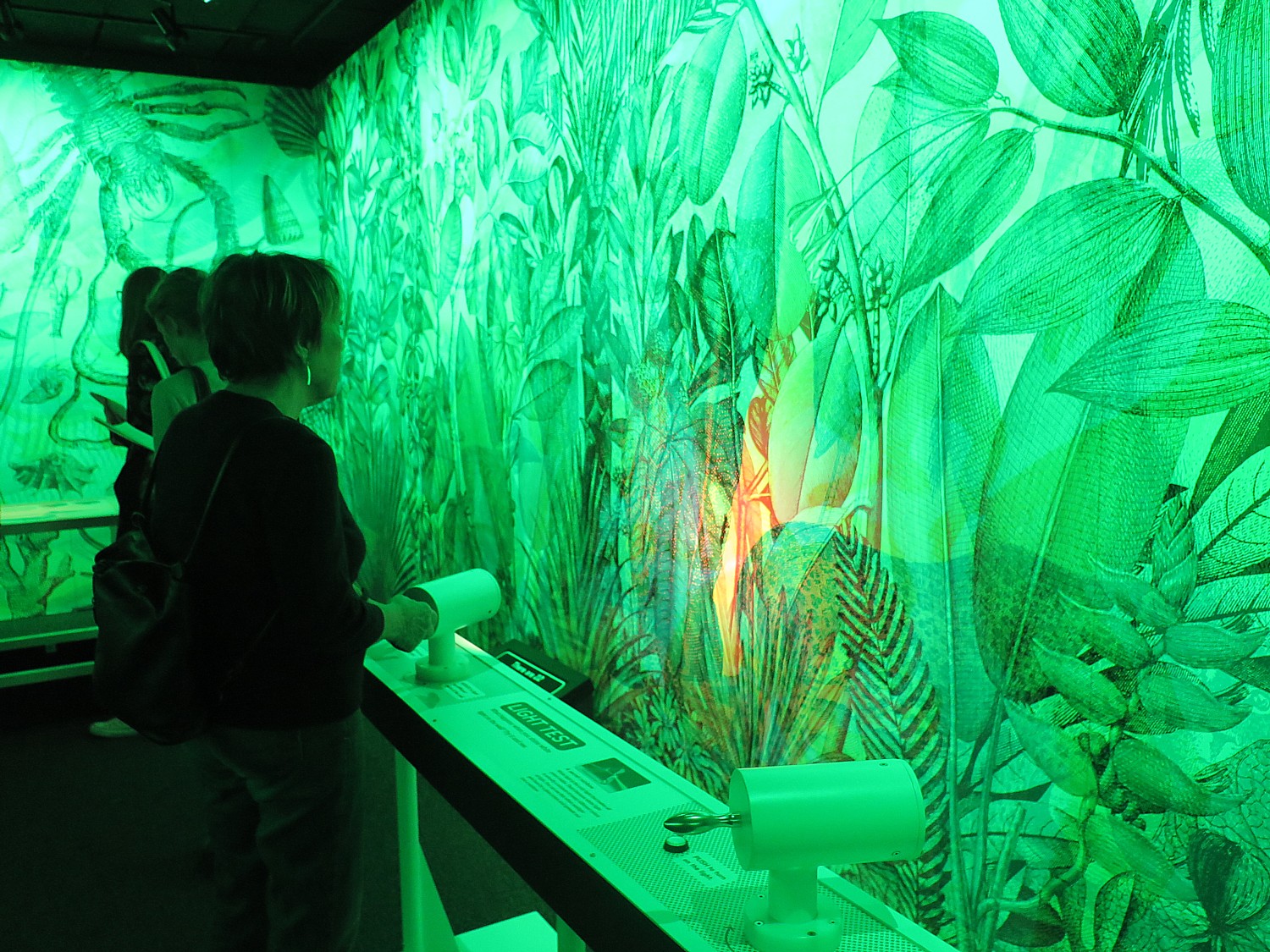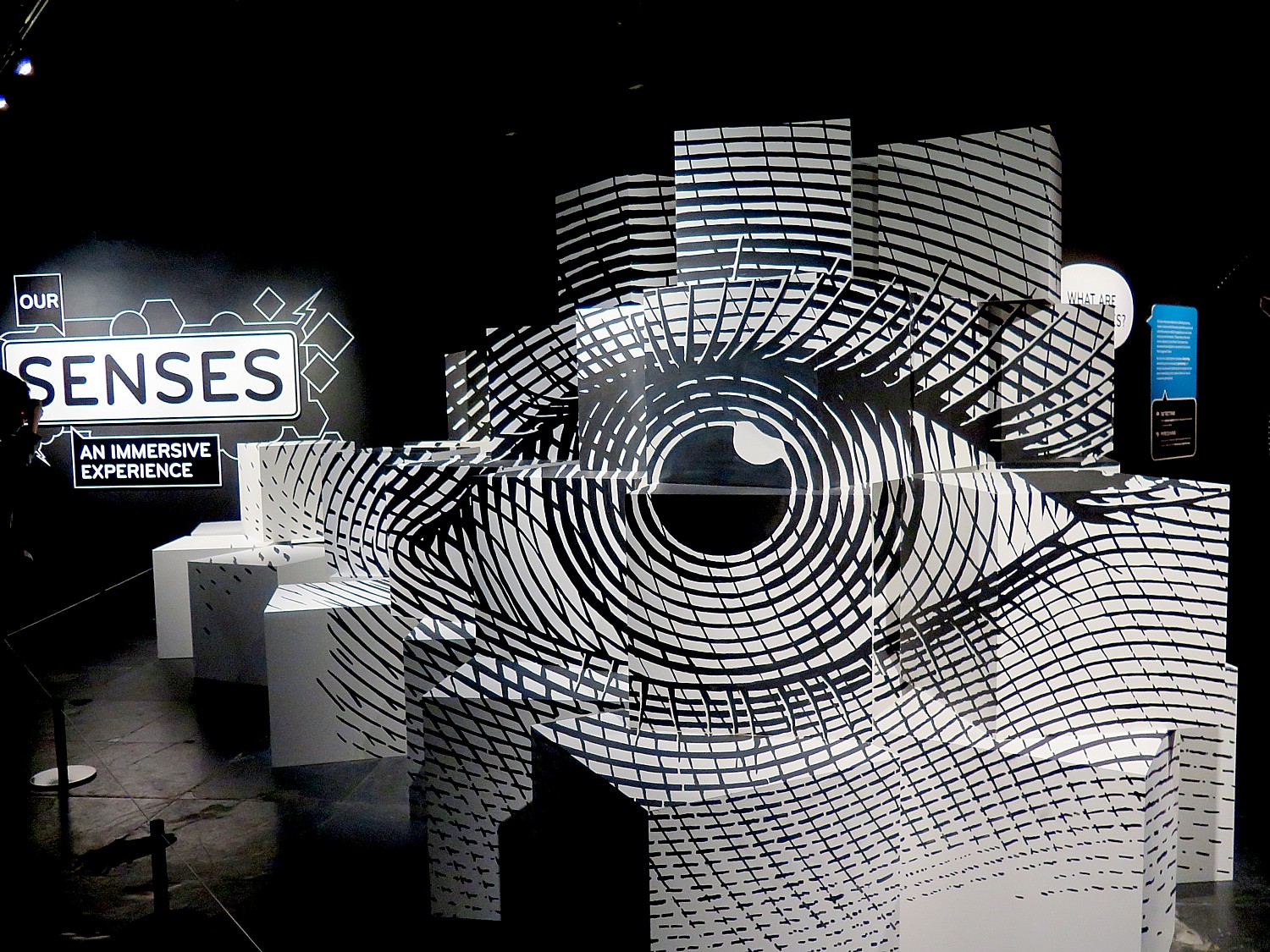
By Karen Rubin, Travel Features Syndicate, goingplacesfarandnear.com
You are in a room. There’s a mural on the wall with drawings of animals. There is red light and you see a set of animals; then the light turns blue and you see a different set of animals.
In another room, you try to build blocks looking through glasses that turn them upside down. It’s disorienting, and that’s the point.
In another room, you are tricked into thinking two squares on a checkerboard are different shades of grey, when in fact, they are the same.
In another room, you feel off balance by the swiggles of black lines on the walls that don’t equate with the flat floor you are standing on.
In another, you push a button to see the vivid, fluorescent colors of a flower as a bee would see them.
In the new, highly experiential exhibition Our Senses: An Immersive Experience opening at the American Museum of Natural History, a series of 11 funhouse-like galleries dare visitors to rely on their senses—and then reveal how and why what we perceive is not all, or exactly, what’s actually occuring around us. Inspired by extraordinary diversity of sensory “super powers” in species, including humans, across the natural world, Our Senses takes experiential exhibition to a new level. Our Senses opens for a weekend of Member previews beginning on Friday, November 17, and will be on view to the public from Monday, November 20, 2017, through Sunday, January 6, 2019.
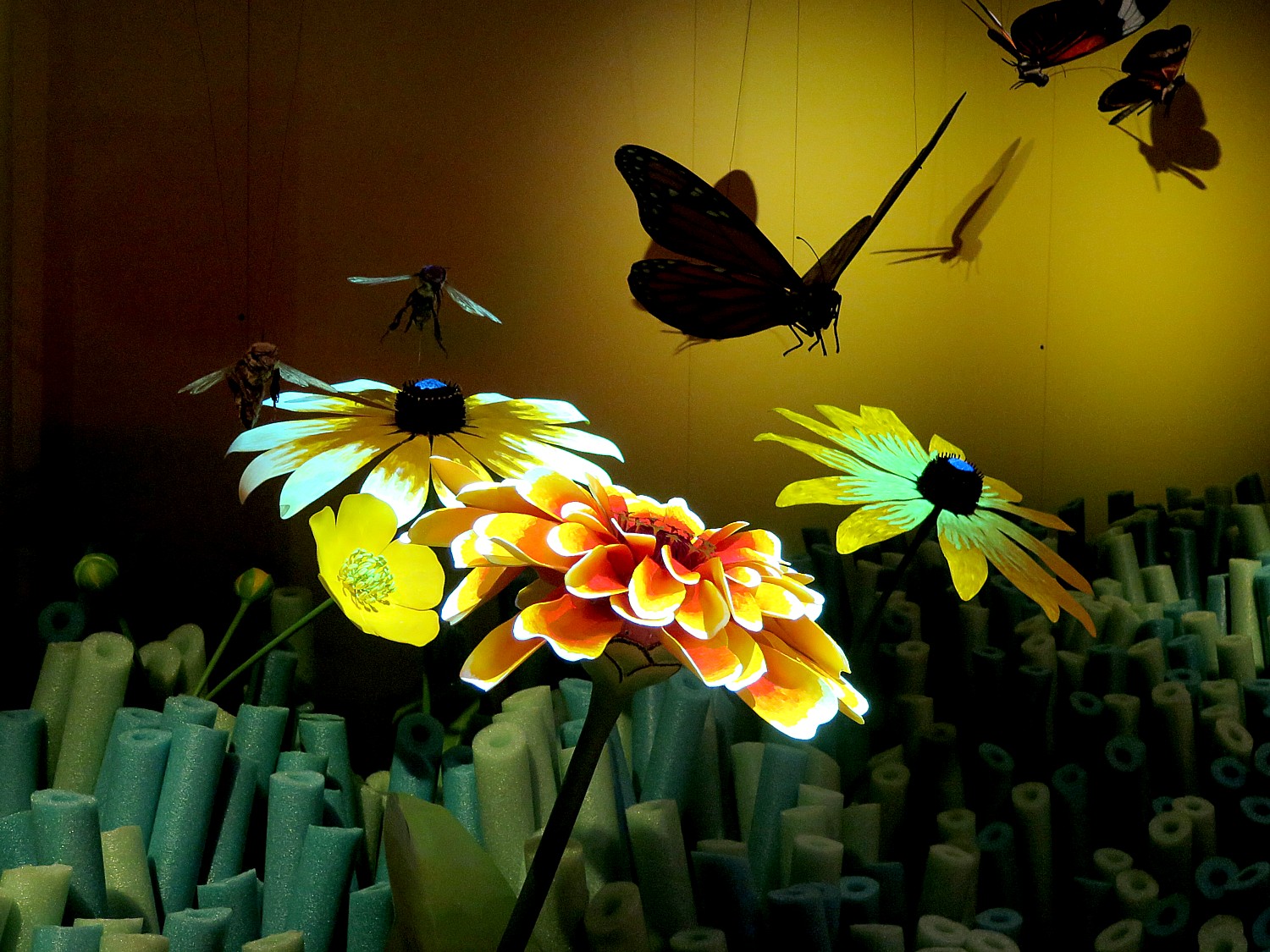
“Our senses are essential to how we live and make sense of the world around us. They provide pleasure, warn us of danger, and allow us to interact with one another,” said Ellen V. Futter, President of the American Museum of Natural History. “But how exactly do they work, why did they evolve the way they did, and what things are we not able to sense or perceive accurately? In a kind of ‘sequel’ to our 2010 exhibition about the brain, Our Senses: An Immersive Experience will explore the intriguing power of our sensory perceptions, offering our visitors not only highly enjoyable learning experiences, but an enriched perspective on what makes us human.”
She adds, “Spoiler alert: we have way more than five senses.”
“In a way, this exhibit is a sequel and extension of the 2010 exhibit about The Brain and cognition [which also was curated by Rob Desalle who curated “Our Senses: Am Immersive Experience.”]. While senses gather information and are highly evolved capacities, we can’t make sense of our world without the brain.” That is the role of prior learning, prior experience, culture, which prime our senses, focus our attention, and trigger the brain to interpret and perceive and combine the different stimuli into a message, idea, concept, action.
Human senses, and human brains, adapted over millennia to help our ancestors survive by shaping and enhancing their perceptions of everyday encounters. Our Senses reveals how until recently in our evolutionary history, humans have been oblivious to some of nature’s ubiquitous signals, including UV and infrared light, very high- and very low-frequency sounds, and electric fields. With the advent of new technologies, scientists now know those signals are all around us—whether or not perceptible to us through our senses alone. But detecting things is not enough, because our ears and eyes alone cannot create a conscious perception—that requires a human brain. Human sensory perceptions may seem like windows into the outside world, but actual perceptions are created in the brain.
“How we sense the outside world has been on humans’ minds probably since our species could think about thinking,” said Our Senses curator Rob Desalle, who is a curator in the Division of Invertebrate Zoology. “The evolutionary nature of how and why we sense our surroundings the way we do made this a perfect topic for our museum to explore. This exhibition will immerse visitors in galleries that test their senses, and give them some tools to approach the age-old human question of how we sense the world.”
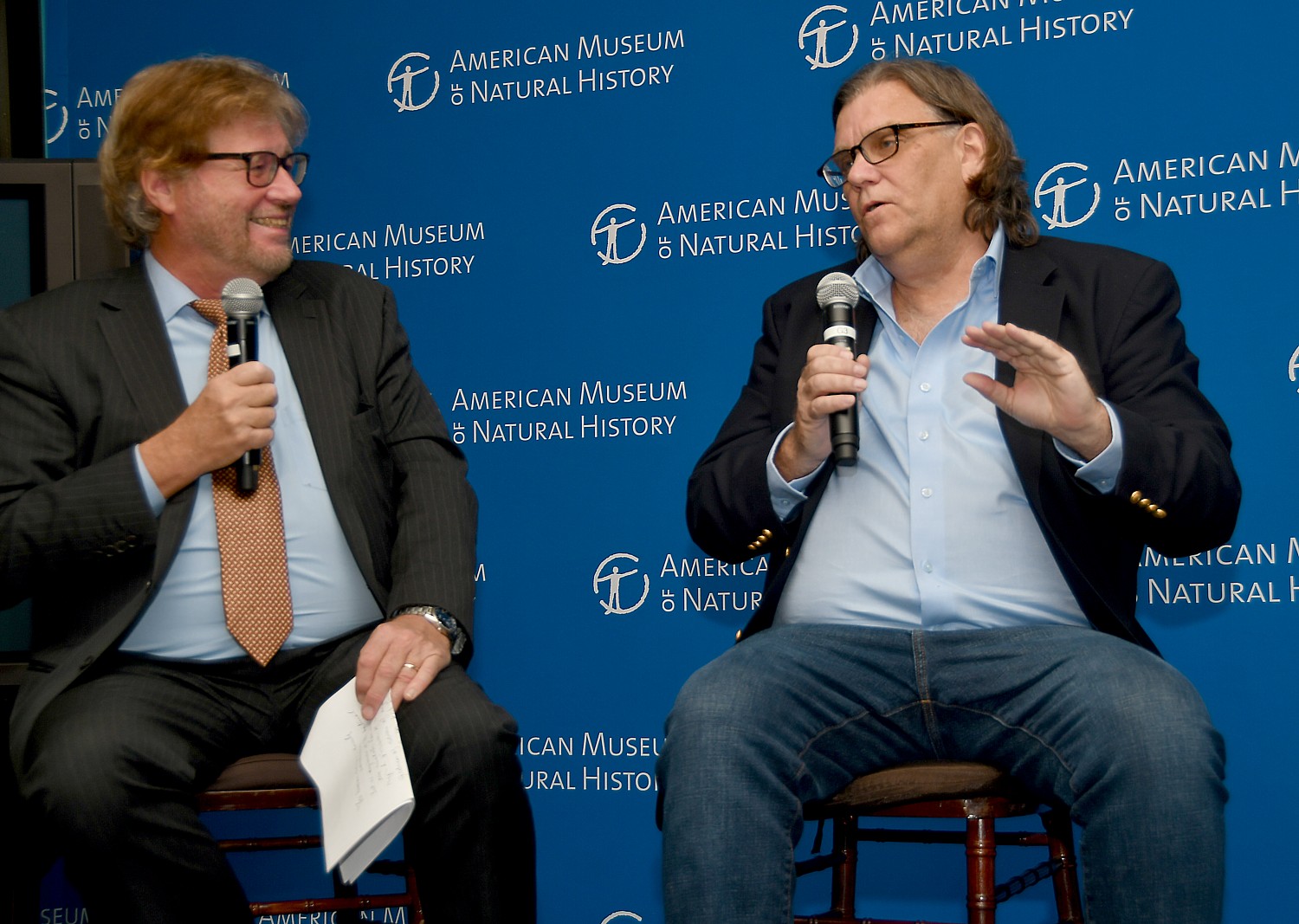
DeSalle has overseen several major exhibitions, including Brain: The Inside Story, which explored how the human brain uses molecular, chemical, and electrical signals to interpret information and learn at every stage of life, which carry into this exhibition.
Visitors walk through 11 interactive galleries designed to test perceptions and illuminate the complex relationships between sensing and perceiving. A musical soundtrack customized for each space enhances the immersive experience. In addition, a live presenter in the exhibition gallery will invite visitors to discover why humans have senses and what’s unique about human perception—including why human beings are the only species that creates imaginary sensory experiences and shares them with others through language.
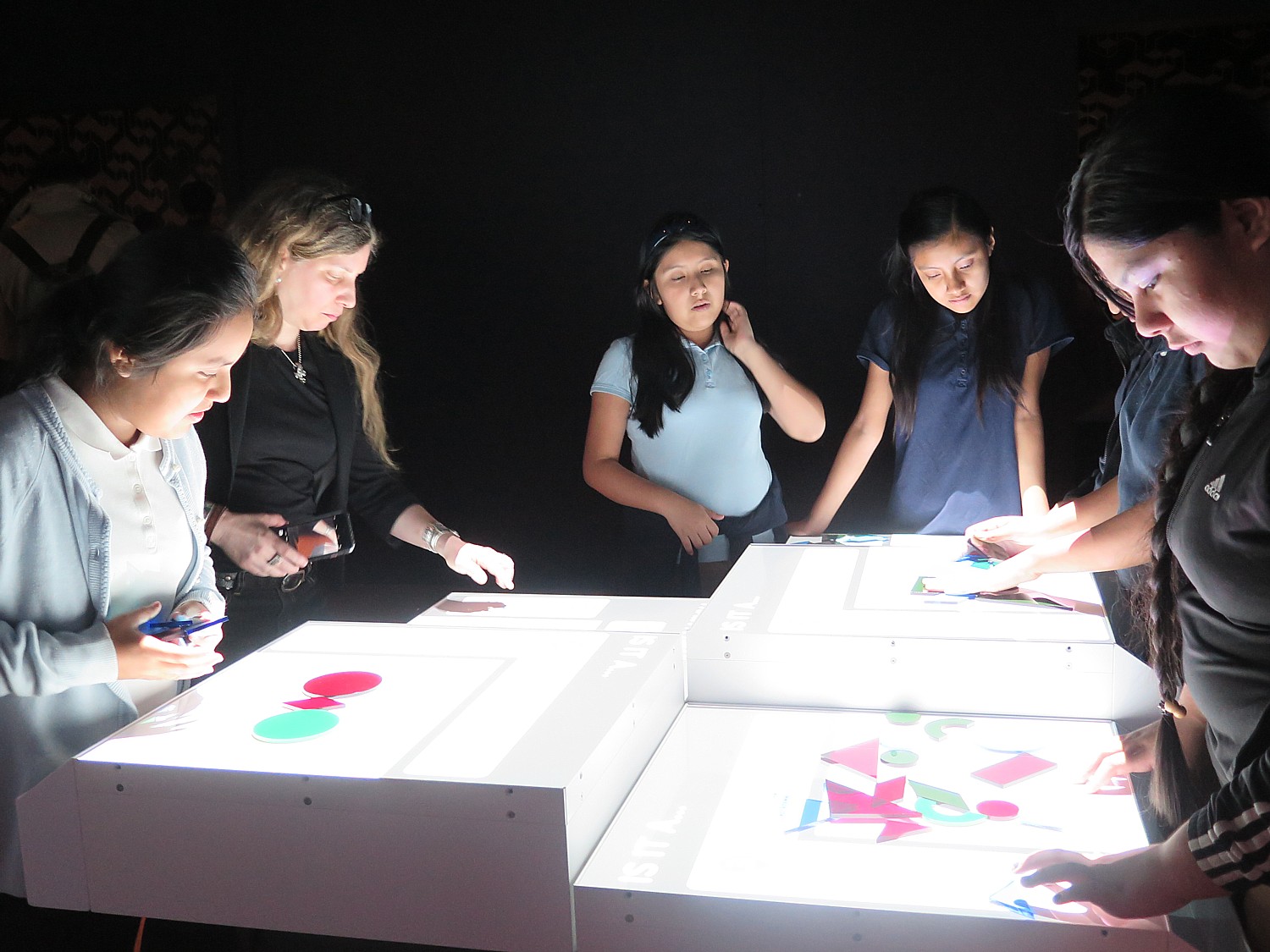
The exhibit is laid out in a way that will particularly appeal to younger people – they will particularly love the puzzles and illusions – providing an understanding of how they perceive the world that will be foundational to learning. But adults, giving more intense look, will find some up-to-the-minute research: for example, that birds can regenerate the cilia in the ear that if humans lose it, lose their hearing, so scientists are studying if cilia can also be regenerated in humans; that male peacocks don’t just use their stunning plumage to visually attract a mate, they move it so it produces a sound, imperceptible to humans, but that is attractive to females.
There is a 20-minute live presentation that really brings home the message: we have more than five senses, the ones that we use to navigate the outer world and let us know where we are in space. We also have inner senses that monitor when we are hungry, thirsty, tired, oxygen-deprived and need to breathe. Every animal – even single-cell animals – have some senses and many animals have senses that are superior to humans, humans are the only animal (that we know of) that can imagine and communicate.
“No other animal can conjure up whole scene using complex signals. Only humans can create imaginary sensory perception and share through language. For example, only humans can make up a story and share it,” the presenter tells us.
“Humans don’t’ just take information into the brain, we can send information out. We can imagine a sensory experience and make it real: create food, fashion, art, architecture, machines, melody and manuscripts.
“Most sensory experiences we have are products of our imagination. We don’t just experience what is – we create what we imagine, then share it with others.”
“Nothing makes sense in absence of evolution,” DeSalle says. He points to the fact that single-cell animals have a primordial sense of touch, they can determine where they are in space. “Our senses go back 3.5 billion years, to the origin of life.”
“Our brain and senses have evolved so that the brain can process what the senses take in with rapid response,” he says. “Because of the way brain evolved, we have some wild ways of dealing with information… Sometimes there is conflict between the brain and signals the senses receive (there are examples in the exhibit) – where we are primed to see something else, but interpret based on what we already sense. That is Evolution: to deal with rapid response.”
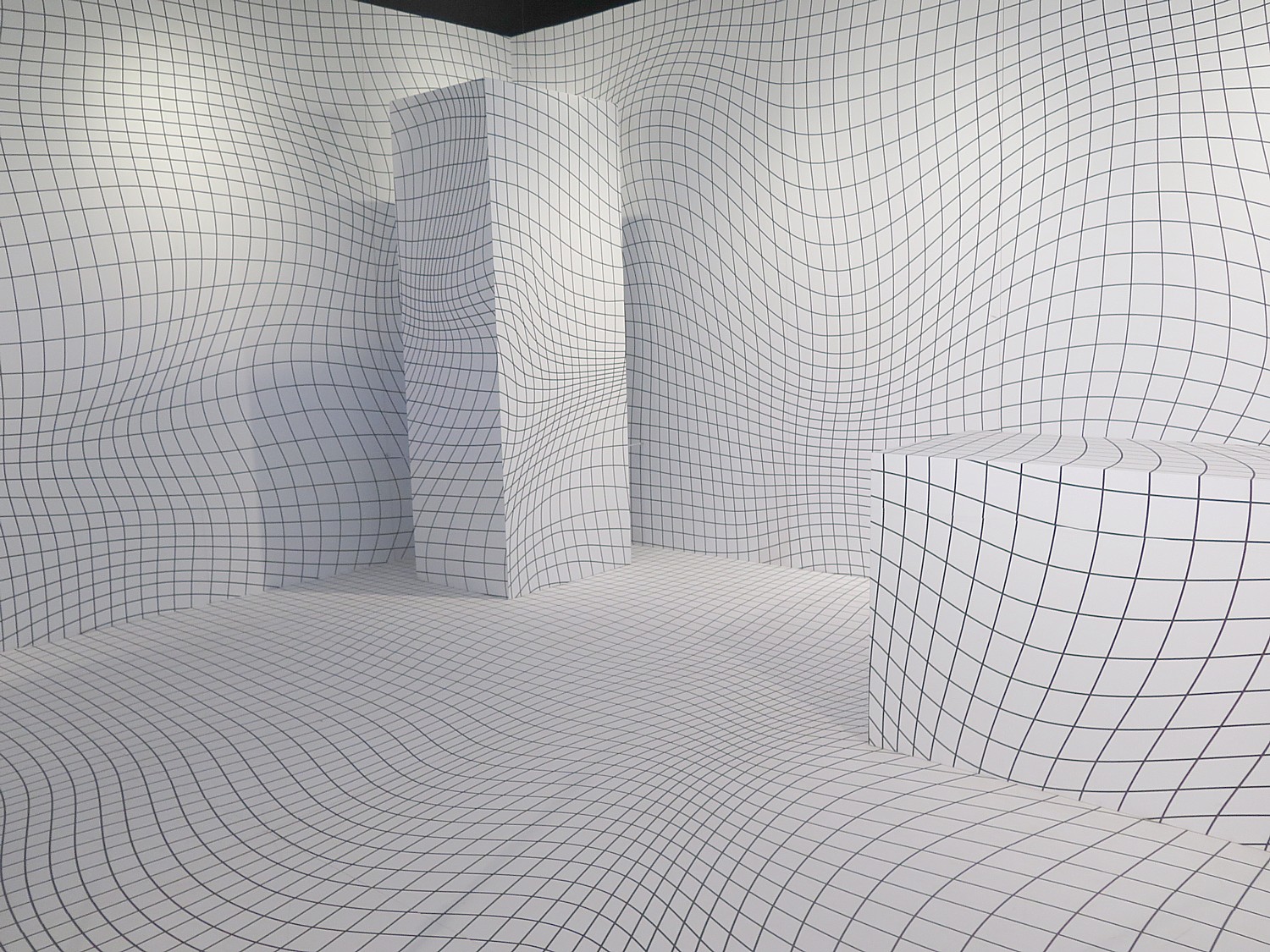
For example, the exhibit shows how we are primed to focus – based on internal needs, experience or habit or prompts– in order to break through the clutter of sights and sounds.
Senses are our source of information about the world, without which, we wouldn’t be able to survive. Take the sense of smell, for example, which helps us determine which food is edible, and which is rotten and could cause disease.
There is an incredible spectrum of the capabilities of senses – many animals exceed our own; humans have a particular space on the spectrum. For example, humans see only a narrow range of light compared to other animals and do not have very sensitive touch. But humans build machines that allow us to sense beyond our range – think of microscopes, telescopes, night-vision glasses, hearing aids, cochlea implants.

You need at least 1 ½ hours to go through – even more if you want to do the immersive activities. And it is helpful to go through once, but then go back and spend more time reading the explanations.
Entrance is by a timed ticket (free with admission), which you can obtain online before you come, or when you arrive at the museum.
Our Senses is open from Monday, November 20, 2017, through Sunday, January 6, 2019. (Members will be able to preview the exhibition starting on Friday, November 17, through Sunday, November 19.) In conjunction with the exhibition, OLogy, the Museum’s science website for kids, has an exhibition-related feature about optical illusions and what they reveal about the human brain and our species’ evolutionary past. Also, Our Senses Curator Rob Desalle explains the human brain for kids in a video: Why is the brain so wrinkly? What does the brain do while we sleep? DeSalle, curator in the Museum’s Division of Invertebrate Zoology, answers these questions and more about one of our most vital organs. (Click goo.gl/UMQw7B)
The exhibition is designed and produced by the American Museum of Natural History’s award-winning Exhibition Department under the direction of Lauri Halderman, vice president for exhibition.
Our Senses is supported by Dana and Virginia Randt.
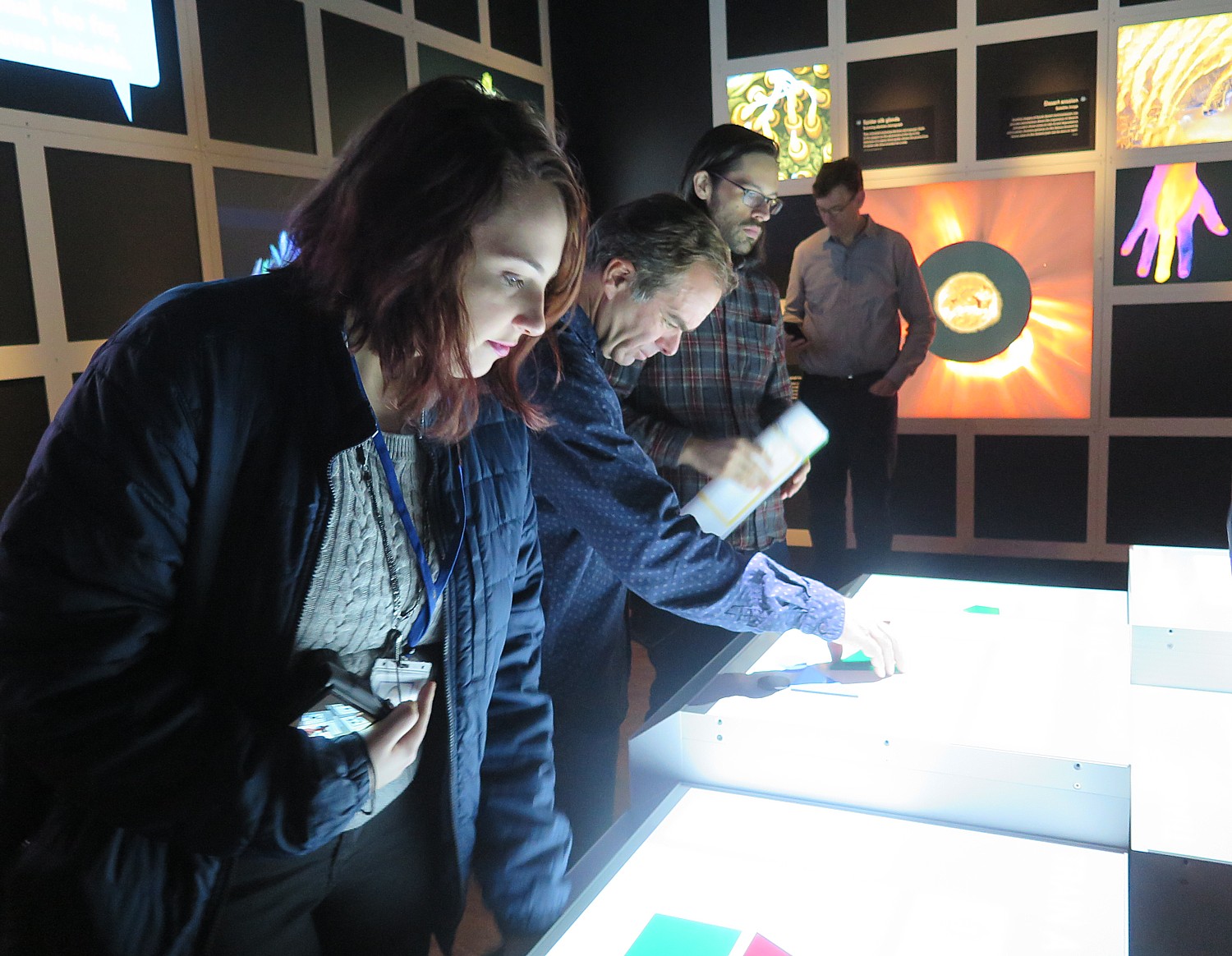
A program, “The Neuroscience of Illusion,” with master illusionist Apollo Robbins and neuroscientists Stephen Macknik and Susana Martinez-Conde will be offered Tuesday, Dec. 5 at 7 pm ($15, Seniors and Students $13.50, members $12); special access to the Senses exhibition available to ticket holders one hour prior, 6-7 pm; tickets at amnh.org.
There’s still time to take in the extraordinary “Mummies” exhibit, on view until Jan. 7, 2018 (admission by timed ticket; need the General Admission Plus 1).
Visiting the Museum
The American Museum of Natural History, founded in 1869, is one of the world’s preeminent scientific, educational, and cultural institutions. The Museum encompasses 45 permanent exhibition halls, including those in the Rose Center for Earth and Space and the Hayden Planetarium, as well as galleries for temporary exhibitions. It is home to the Theodore Roosevelt Memorial, New York State’s official memorial to its 33rd governor and the nation’s 26th president, and a tribute to Roosevelt’s enduring legacy of conservation.
The Museum’s five active research divisions and three cross-disciplinary research centers support approximately 200 scientists, whose work draws on a world-class permanent collection of more than 34 million specimens and artifacts, as well as specialized collections for frozen tissue and genomic and astrophysical data, and one of the largest natural history libraries in the world. Through its Richard Gilder Graduate School, it is the only American museum authorized to grant the Ph.D. degree, and, beginning in 2015, the Master of Arts in Teaching (MAT) degree, the only such freestanding museum program. Annual visitation has grown to approximately 5 million, and the Museum’s exhibitions and Space Shows are seen by millions more in venues on five continents.
The Museum’s website, mobile apps, and MOOCs (massive open online courses) extend its scientific research and collections, exhibitions, and educational programs to additional audiences around the globe. Visit amnh.org for more information.
Museum admission is free to all New York City school and camp groups.
Pay-what-you-wish admission is available only at ticket counters, where the amount you pay is up to you.
General Admission, which includes admission to all 45 Museum halls and the Rose Center for Earth and Space but does not include special exhibitions, giant-screen 2D or 3D film, or Space Show, is $23 (adults), $18 (students/seniors), and $13 (children ages 2–12). All prices are subject to change.
General Admission Plus One includes general admission plus one special exhibition, giant-screen 2D or 3D film, or Space Show: $28 (adults), $22.50 (students/seniors), $16.50 (children ages 2–12).
General Admission Plus All includes general admission plus all special exhibitions, giant-screen 2D or 3D film, and Space Show: $33 (adults), $27 (students/seniors), $20 (children ages 2–12).
American Museum of Natural History, Central Park West at 79th Street, is open daily (except Thanksgiving and Christmas), 10 am–5:45 pm. For additional information, call 212-769-5100 or visit the Museum’s website at amnh.org. Become a fan of the American Museum of Natural History on Facebook at facebook.com/naturalhistory, follow on Instagram at @AMNH, Tumblr at amnhnyc, or Twitter at twitter.com/AMNH.
See also:
_______________________
© 2017 Travel Features Syndicate, a division of Workstyles, Inc. All rights reserved. Visit goingplacesfarandnear.com, www.huffingtonpost.com/author/karen-rubin , and travelwritersmagazine.com/TravelFeaturesSyndicate/. Blogging at goingplacesnearandfar.wordpress.com and moralcompasstravel.info. Send comments or questions to [email protected]. Tweet @TravelFeatures. ‘Like’ us at facebook.com/NewsPhotoFeatures
